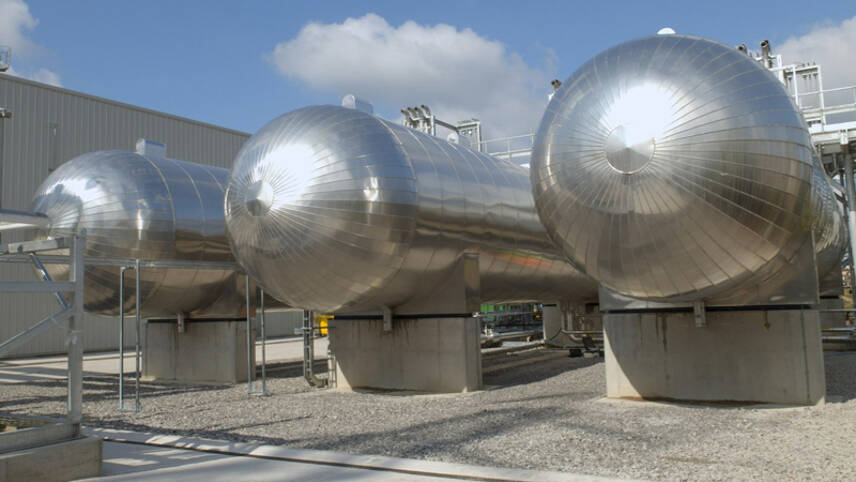Register for free and continue reading
Join our growing army of changemakers and get unlimited access to our premium content

Pictured: Liquid carbon storage tanks at the plant. Image: TCE
The CCU plant has been added to the firm’s manufacturing plant in Northwich and has a stated capacity of up to 40,000 tonnes of CO2 capture each year. It will be used to capture emissions resulting from the processes of manufacturing salt, sodium carbonate and sodium bicarbonate. 40,000 tonnes is equivalent to 10% of the emissions generated by TCE in the UK every year.
For the past ten months, TCE has been testing the CCU plant at a limited capacity and has been measuring the purity of the captured CO2. It is hoped that the captured CO2 can be supplied to the food industry, which has faced shortages in recent months, and to manufacture lower-carbon sodium bicarbonate at the plant itself. Sodium bicarbonate is a key ingredient in products ranging from glass, to detergent, to pharmaceuticals. A key use in healthcare is haemodialysis.
edie reached out to TCE for more information on how the carbon capture process at the plant works. A spokesperson confirmed that the facility uses Advanced Amine Technology provided by US-based industrial solutions provider Pentair. This process involves taking exhaust gasses and using a flue gas scrubber to remove impurities. The gases are then transferred into an absorber column where they are mixed with an amine-based fluid that captures CO2. When heated in a stripper column, that liquid releases the CO2, leaving the amine solution free for reuse.
TCE has recorded a 50% reduction in the emissions intensity of its products since 2000 and is aiming to reach an 80% reduction by 2030. It sees CCU playing a significant role in delivering this 2030 goal, after improvements in energy and material efficiency and the use of combined heat and power (CHP) units helped to deliver the progress to date.
Government involvement
The UK Government provided £4.2m in grant funding to the TCE project, with the private sector – mainly TCE’s parent firm Tata Group – footing the remainder of the £20m costs. The Government funding was provided through the Department for Business, Energy and Industrial Strategy’s (BEIS) £505m Energy Innovation Programme, which launched in 2015 and closed to applications in 2021. Around £100m of the Programme’s budget was allocated to CCU and carbon capture and storage (CCS).
The Government’s overarching commitment on CCS is for four industrial clusters utilising CCS to be brought online using a mix of private and public finance – the first of which should come online this decade. Specifically, BEIS is targeting a total national CCS and CCU capacity of 20 million tonnes by 2030.
TCE’s plant is the largest in the UK at present, but will be the forebear to these larger projects. BEIS has selected the East Coast Cluster around Humber and Teesside and HyNet North West in Liverpool Bay as the first two large industrial cluster schemes which will receive public funding at scale, provided that they can prove their business case and evidence the environmental benefits of their innovative technologies.
BEIS Secretary Kwasi Kwarteng said TCE’s plant is “cutting-edge” and “demonstrates how carbon capture is attracting new private capital into the UK and is boosting new innovation in green technologies”. He added: “We are determined to make the UK a world-leader in carbon capture, which will help us reduce emissions and be a key part of the future of British industry.”
Representing the Government at the opening of the TCE plant was Mike Amesbury MP, the Labour representative for Weaver Vale. He said: “Manufacturing has been key to this area for over 150 years so it’s great to be part of such an historic moment. Even though, today, there are many competing agendas, sustainability is still crucial and we must continue working towards net-zero.
“The investment made by TCE in this leading-edge carbon capture plant will not only support the reduction of carbon dioxide emissions here, but it will also pave the way for others to use this technology.”
The opening of the plant comes shortly after the UK Government opened its first licencing round for projects that will enable the large-scale storage of captured carbon under the North Sea. While TCE will use and sell its captured emissions, some other firms intend to store them in this manner.


Hmm, is this really locking up the carbon as most used for Sodium Bicarbonate results in the release of CO2. Therefore this is delayed release not locked away….